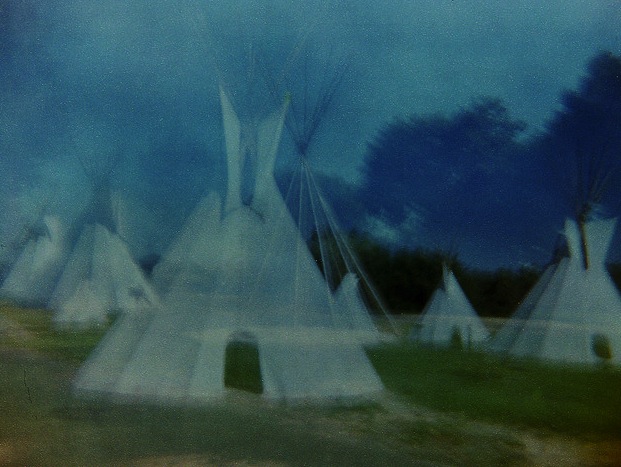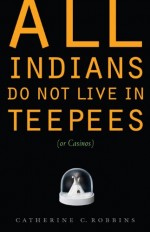
In Squaring Off, Zócalo invites authors into the public square to answer five questions about the essence of their books. For this round, we pose questions to Catherine C. Robbins, author of All Indians Do Not Live in Teepees (or Casinos).
The United States is a nation with only a loose sense of the past, and most Americans give only superficial thought to the history of the nation’s Indian tribes. But it’s a history with significant effects, according to Robbins, on how we live now and on how we (often incorrectly) view Indian tribes.
1) If Indians do not all live in teepees (or casinos), where are they living today?
 More than half of all American Indians today live in cities. The largest populations are in New York (87,000) and Los Angeles (53,000), but Indians are virtually invisible in those cities. In places like Anchorage, Tulsa, and Albuquerque, they comprise five to ten percent of the population. One stereotype is that in the past Indians were scattered and nomadic, but southwestern Puebloan people built well-engineered cities and towns and agricultural systems with thousands of residents at Chaco Canyon, Jemez, and Taos. Longhouse communities characterized northeastern life. At Cahokia (Illinois), we see sophisticated urban development. Even the Plains Indians, who moved frequently to follow the bison, remained within definite boundaries. People crossed great distances to trade turquoise, macaw feathers, shells-and, my favorite, chocolate!
More than half of all American Indians today live in cities. The largest populations are in New York (87,000) and Los Angeles (53,000), but Indians are virtually invisible in those cities. In places like Anchorage, Tulsa, and Albuquerque, they comprise five to ten percent of the population. One stereotype is that in the past Indians were scattered and nomadic, but southwestern Puebloan people built well-engineered cities and towns and agricultural systems with thousands of residents at Chaco Canyon, Jemez, and Taos. Longhouse communities characterized northeastern life. At Cahokia (Illinois), we see sophisticated urban development. Even the Plains Indians, who moved frequently to follow the bison, remained within definite boundaries. People crossed great distances to trade turquoise, macaw feathers, shells-and, my favorite, chocolate!
2) What incorrect stereotypes do we see today-and why?
Ignorance perpetuates stereotypes. They also persist because they are useful. Here’s a convenient stereotype: Indians are sitting around the reservation, collecting free health care and education. Politicians use it to advocate ending the trust responsibility, the obligations the U.S. government took on when it made deals with tribes for millions of acres of Indian lands.
Viewing Indians as mystical tree-huggers-another stereotype-is great marketing. But it can be dangerous, as we saw when three people died in a white Arizona New Age sweat lodge. Such an outcome allows us to ignore the modern Indian’s contributions in science and medicine and, conversely, the damage Indians sometimes do to nature.
The newest stereotype is that gaming has made tribes rich and rapacious, which is convenient for whites fighting casinos-the NIMBY factor. But only half the tribes have casinos and, for most, the revenues are modest compared with other businesses.
3) When will America’s responsibility to Indians be over, if ever?
The U.S. Constitution defines Indian nations as sovereign entities, not just interest groups. Built on that foundation, about 300 years of treaties, laws, statutes and land deals constitute a complex relationship that might not ever end. Remember, whites got benefits too, millions of acres of land and access to resources. If the “responsibility” ends, will it be reciprocal? Will lands be returned to Indians?
4) Increased sovereignty and greater self-determination have also given rise to corruption and greed in tribal governments, as you mention. Are Indians threatening their own survival?
Greed and corruption are equal-opportunity vices, and Indians have never had a dispensation. Some tribal members are not happy with gaming for that reason. The Navajos voted against gaming twice, because of cultural prohibitions. But the tribal government, which has a long history of corruption, ignored the vote and went ahead with casinos.
The greater threat comes from the lack of job and educational opportunities on reservations, which drives the young into cities and towns. Urban life doesn’t erase unique tribal cultures that Indians bring with them, but it does weaken them.
5) So how should we remember the past-and why is the continued sovereignty of American Indians important to our future?
Americans suffer from selective and willful amnesia, but how we remember the past is important. William Faulkner wrote, “The past is never dead. It’s not even past.” The past is alive in the memories of the people and their stories, so we remember by listening to them, today, not by freezing them in the past.
American Indians are also important to our future because of their knowledge. Some years ago, Hantavirus hysteria focused on the Navajo reservation, and the CDC sent a squad of scientists to the reservation. They concluded that Hantavirus spread through the urine of a field mouse. We learned later that Navajo medicine men had long ago noticed that link and had regularly cautioned reservation residents to keep their hogans clean, to keep the field mice out of their homes. That’s just a small example. Indians were the first artists, scientists, and historians here, and we can learn from them.
Buy the book: Amazon, Powell’s, Skylight
*Photo courtesy of Dead Air.



